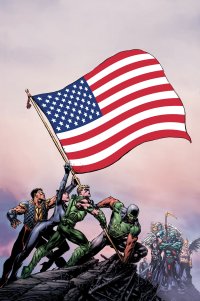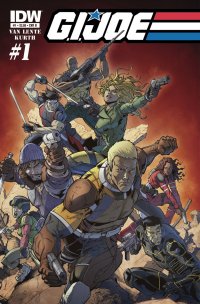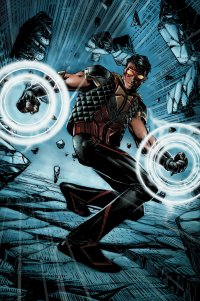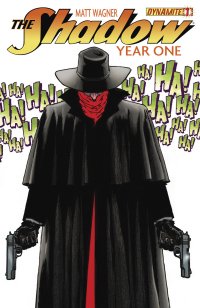Justice League of America #1 ($3.99, DC)
by D.S. Randlett (@dsrandlett)
Since The Ultimates, it seems like it’s been everywhere. Superhero teams acting under the auspices of government agencies has been happening have become the standard issue. The rebooted DCU started its entry into this trend with Stormwatch, which I haven’t been keeping up with. I don’t know if its been sticking by its “mission statement” of being the Counter League (in spirit if not purpose), but with the rise of this week’s Justice League of America I can see that book being either phased out or changed up in some way. But then, I’ve privately maintained the thought that those Wildstorm characters should have stayed in their own universe where they could effectively comment on the DCU’s icons rather than play second fiddle to them. But I suppose that that’s another column.
Like it or not, the superhero is still our culture’s dominant living mythology, and even when the comics are poor or particularly shallow at a given time, they tend to be a place where our culture talks about itself. Sometimes it’s intentional on the part of the creators, while at other times it’s through an odd sort of cultural osmosis. The current dominant superteam archetype, which includes both of the current Justice League titles and the Avengers film (I can’t speak to the Marvel team books currently, as I am woefully behind on them), of the team being operated by some kind of government agency seems to me symptomatic of a specific epoch in the War on Terror culture.
With the original incarnations of most Superhero teams like the Justice League or The Avengers, they presented a very different mythology. In that post World War II, pre Vietnam era, the superteam represented a group of citizens assembling for a common purpose in a Tocquevillian vision of a New England general assembly wearing tights and packing lasers. The Justice League banded together to defeat Starro, The Avengers Loki, echoes of the nightmares of a monolithic, conquering other. Even the X-Men were citizens banded together, even though they were fighting a battle against the dominant culture, did so as engaged activists fighting in order to save and better their world rather than tear it down out of a sense of angry bitterness.
So what of the superhero team of today? On the one hand, we have the heroes as gods, an approach pioneered by Grant Morrison in his run on JLA. Morrison was more or less able to get away with this shift of the superhero from the image of the engaged citizen to the image of the transcended moral being because he was writing stories about personal struggles on a superhero canvas. For Morrison, power comes from feeling, and his stories tend to reflect that, with his villains standing in for our anxiety dreams, his heroes our dreams of glory and flight. After the success of the Morrison approach, I think many writers started to write in his vein, but they took many of the wrong lessons to heart. Many team stories ended up becoming about power itself, essentially about Operation Shock and Awe, marvelling in its excesses (Thor bashing up alien ships in The Ultimates comes to mind as I write this) while serving no real moral purpose. After all, at the time of Iraq, there was a blood debt to be paid, and it didn’t matter who did.
So now here we are, with the heroes of the main Justice League title still retaining their Morrison-esque god status to the audience (but not to there own narrative) while being ordered around by Steve Trevor, a Nick Fury stand in. Instead of the superteam as a group of citizens, or as the arm of post 9/11 vengeance, we have the drone warfare being waged by the gods. It’s an elitist vision, despite the pretense of certain members among the ranks coming from the working classes. The power of the Justice League now places them above the citizenry while they wage war at the behest of a shadowy government entity, HOMESEC for the DCU.
What makes the new Justice League title, Justice League of America, interesting is its reflection of the fact that we have no idea who our enemies really are, just that we have them (or, we insist on having them). The core conceit of JLA is that this is a team formed up to be able to take down the actual Justice League just in case they get out of hand. They are drones built to fight against the drones wrapped up in a carefully engineered PR package by the spooks Amanda Waller and Steve Trevor. In terms of mythology, it’s a compelling completion of what was (poorly and aimlessly) started in last year’s Justice League.
In artistic terms, JLA isn’t too shabby. If anything, this year is shaping up to be DC’s “Year of the Mulligan,” as creators are shifted around and concepts are retooled across the line (see the recent Green Arrow reboot). The core Justice League creative force, Geoff Johns remains in his place, but his scripts in the past couple of months have taken on a renewed sense of focus. Either he’s finally getting around to tell the story he wants to tell and has been setting up all this time, or he’s finally found a way into these characters. Either way, his Justice League of America script is a big step up from what we’ve seen from him since the New 52 started (at least).
He has his critics around this place, but I’ve always thought that once Johns finds his way into his characters, he can write breezy, fun, and gripping superhero comics like no one else. He hasn’t written one of those in a while, but this month’s JLA just clicks along, doing everything that a first issue should. It’s rare these days to find a first issue, particularly in superhero comics, that feels the need to assemble its players and move its story forward with a sense of momentum, and I wasn’t expecting it from this one. Johns is often guilty of the “long con,” setting up things in early issues that pay off later, while those same early issues feel aimless in and of themselves. He avoids that trap here, and it’s as big a surprise as finding out he’s found a certain superhero groove again.
David Finch has improved remarkably since I last saw his work (Avengers way back when). He adopts a shadowy style here that really works for the tone that this series is going for. His portrayal of the New 52 Amanda Waller is refreshing. While she’s still not fat anymore, Finch does give a sort of older, grizzled vet sort of look like her femme fatale days are recently behind her now that she’s running the show. Basically, she feels like Amanda Waller again. His storytelling is well executed, but sort of de rigueur. There’s nothing here that will blow your hair back, but nothing that will take you out of the story, either.
Justice League of America is a good superhero book, and is well worth your time despite some of the things that it represents. Whether or not Johns and company are intent on using that to engage with the genre more deeply remains to be seen, but if they stick with telling a simple superhero yarn with this much verve and energy, it won’t be such a great loss.
Rating: 




Out of a Possible 5 Stars
 G.I. Joe #1 (IDW Publishing, $3.99)
G.I. Joe #1 (IDW Publishing, $3.99)
By Devon Sanders (@devonsanders)
Confession… I never really cared much for Star Wars.
Like many other kids born in the 70’s or 80’s, I lined up to watch the Star Wars movies but it was more a thing for me to do than any sort of cultural touchstone. No; G.I. Joe was my thing.
I’ll never forget seeing my first G.I. Joe commercial. Hasbro, the company who made the toys, worked with Marvel Animation to produce a commercial that simultaneously sold kids on the toy AND the comics. It was 30 seconds of explosions, jetpacks, laser rifles shooting and hitting nothing in particular and a rally cry that lives in my heart to this day, “YO, JOE!”
I rushed to the comic book store and got my G.I. Joe #1. I hurried home from school every day to watch the cartoon and there, I truly found my heart. I was home. As the years went on, I and my comics became more “serious” and I put down such childish things such as Joe. Life went on and Joe became less of a thing to me. That was until I heard G.I. Joe creator Larry Hama was due to show up at a local comic convention. I trekked in the cold with one mission in mind; to meet the man who’d made my childhood so awesome. As I waited patiently to meet him, I tried to figure out exactly what to say to him. “Thanks” wasn’t enough for the man who’d created Destro. I needed something better. I got to the front of the line, G.I. Joe lunchbox, comics and Snake Eyes action figure in hand and quietly handed them to the man who’d created this wonderful. He seemed surprised that I wanted him to sign a lunchbox. The lunchbox meant the world to me. I grew up pretty poor and got free lunches as a kid. This G.I. Joe lunchbox I’d bought as a grown was my time capsule. It was a gift to a boy who so wanted this thing but never understood why his mother said he didn’t need it. He signed everything and I shook his hand, wanting him to know how much meeting him meant to me. Then, the kid in me took over and giddily I thanked him. These words came out, “Thanks for creating this. You were my George Lucas. G.I. Joe has always been my Star Wars.”
On that day I stormed the beaches of every bad day of my childhood.
I’d made the guy who created G.I Joe smile.
Best. Day. Ever.
Since then I’ve read a lot of Joe and some of it has been good and much of it has been not but that really hasn’t bothered me much. Recently, G.I. Joe‘s publisher, IDW announced that one of comics’ most thoughtful writers, Fred Van Lente would be relaunching the title with an all-new #1 and let me tell you…
With G.I. Joe #1, I’m a fan all over again.
America’s first and foremost covert counter-terrorism unit, G.I. Joe has been outed by Cobra. Secrecy, the thing that made Joe so successful, has been spent from their clip. To the greater public, G.I. Joe is now a thing and instead of rolling over, the U.S. government has sent it’s best; the man behind the idea of G.I. Joe, Gen. Joseph Colton to re-forge them into something else. Something better. Something America can fully embrace; make action figures of, so to speak. Six highly skilled men and women are chosen with “ethnicity, gender and service branch” in mind to become the very public face of the new Joe paradigm. Their first mission: take down a Cobra stronghold. Things quickly go sideways as Cobra, with newfound energy and recruits, again takes the offensive, leaving these six in a situation this reader doesn’t know they can survive.
Van Lente smartly and rightly embraces the more ridiculous aspects of the G.I. Joe legacy. The forced demography of the toy line; the ridiculous costuming of heavily trained war veterans, giving it all reason and purpose. Van Lente writes and finds a perfect line of compromise between a G.I. Joe easily recognizable by longtime fans of the comics and probably more important to Hasbro and Paramount, the folks behind the upcoming movie, G.I. Joe: Retaliation. Van Lente establishes his version as a team with legacy and something new to prove. This is meta-text at its best.
Artist Steve Kurth draws a great job in his debut issue. Kurth’s artwork services the writing well; his lines are clean, allowing the eye to follow the action easily from left to right while doing the fast paced things a Joe unit should always be doing.
G.I. Joe #1 is a frankly everything a 12 year old boy or a 40 (cough) year old man could ask for.
Rating: 




Out of a Possible 5 Stars
Vibe #1 ($2.99, DC)
by D.S. Randlett (@dsrandlett)
Vibe is a hard book to review on its own, which lies at the heart of both the book’s biggest problem and some of its more fun elements. In fact, I had originally intended to review Vibe and JLA as one book, but JLA prompted some thoughts that weren’t suited to a review of Vibe.
I’m not that familiar with the original iteration of the title character, just that he is an often ridiculed joke of a Latino token character from the late 80s/early 90s. Geoff Johns’ stock in trade has long been reviving “forgotten” characters, most notably villains, along with flagship heroes like Hal Jordan and Barry Allen. These days, he seems to be interested in taking characters that are often ridiculed outside of fandom (Aquaman, and now Vibe) and making them legitimate contenders for the affections of people who might be fans of superhero movies if not the comic books. But they’d need to read Aquaman or Vibe, because those movies aren’t coming out anytime soon.
Still, Johns, with help from Andrew Kreisberg , does a pretty fair job here. The script is pretty typical origin story stuff, but is enjoyable enough. The point of this issue is to make you like the title character, and it succeeds. Cisco Ramon is a thirteen-year-old child when the forces of Apokolips raid the earth (as seen in Justice League #1, still in stores and digital, True Believers!). While walking with his brothers, he is caught in the event horizon of a boom tube. His oldest brother dies saving his life. Flash forward five years, and he’s an eighteen year old kid with a job at a Best Buy-like store and a deadbeat big brother with a gambling habit. And strange powers that he doesn’t quite know the extent of.
That’s all well and good, but this book simply doesn’t stand on its own. I’ve heard it said elsewhere that it’s a bold move to give this widely reviled character such a central role. The thing is, there’s a difference between a “central character” and a “clean slate that DC can orbit its big plans around.” Vibe is definitely the latter. On the one hand, our experience with the lead suffers. We don’t get idea of what he represents or stands for, we don’t see him struggle in his new role. He’s simply picked up by government agents, drafted into the JLA, and is given the opportunity to avenge his brother’s death. None of this happens at his own hands, and when you start thinking about this character’s motivations, you can’t really find them. He’s basically just following orders. That said, they’ve planted some cool seeds for the character. His connection to the New Gods might end up yielding some interesting fruit, for example.
And it’s a bit of a shame, as Johns and Kreisberg manage to craft a likable Latino character who doesn’t rely on legacy (looking at you, Blue Beetle) for his appeal. Why not let him stand on his own a bit before sticking him into JLA related shenanigans? What’s more, they’re obviously saving his “big moments” for the JLA title, where it’s pretty obvious that he and Green Arrow are the “underestimated badasses” on the squad. As such, one can immediately tell that Vibe’s first big hero moment (the superhero comics version of catharsis) won’t even come in the character’s own book. As such, the book serves as a very fun supplement to another comic, but struggles to stand on its own two feet.
Still, fans of the DCU will still want to check it out. I like to say that this year appears to be DC’s “Year of the Mulligan,” where they retool their more compromised rebooted concepts (sigh) into books that might have some kind of momentum or dramatic force. Vibe seems to be a book where DC can let the “personality” of the DCU can override that of its principal characters. Creatively, that’s a pretty compromising position, but Johns, Kresiberg, and the ever dependable artist Pete Woods manage to pull that balance off here, reminding us the the DCU is still a big, imaginary playground that can be a lot of fun. If this book takes some time to keep walking that balance, that’s fine, but as long as it does it will be a tough book to really recommend to people who don’t care about JLA and might be intrigued by this new(ish) character.
If this book manages to step away from the larger DCU for a bit to find its principal characters, it can only help as there are some interesting things that can be done with this character. As it stands, Vibe is a fun bit of supplemental reading for fans of the DCU that hints at big, fun things to come as DC attempts to make right on the New 52. For everyone else, it simply doesn’t matter.
Rating: 




Out of a Possible 5 Stars
 The Shadow Year One #1 of 8 (Dynamite, $3.99)
The Shadow Year One #1 of 8 (Dynamite, $3.99)
By Jeb D.
Matt Wagner’s Trinity, like The Dark Knight Returns and Superman: Red Son, takes an idiosyncratic view of some of superhero comics’ most famous characters, ignoring decades of accretion and contemporary conventions, and bringing a fresh perspective of the sort that tends to elude the month-to-month presentation of over-familiar characters. One interesting thing about The Shadow is that he managed to get his backstory every bit as convoluted as any of our spandex favorites, in far fewer years. The main problem with the idea of this particular Year One mini trying to excavate the beginnings of The Shadow is that much of that fresh eye on the character was already brought by Garth Ennis’ initial six-issue run kicking off the ongoing series last year, simplifying what was overly complicated, and adding depth where it made sense: in other words, the ground he has left for Wagner to plow is no longer as fertile.
In fact, this first issue less resembles Miller and Mazzuchelli’s Batman: Year One than it does the puzzle-box continuity-tweaking that earlier writers like Roy Thomas used to favor: while I don’t doubt that there is incident and action awaiting us over the next five issues, I get the sense that Wagner’s focus is going to be on clarifying and explicating some of the mess of The Shadow’s “true” identities-the sort of thing that never bothers me, but is evidently catnip to the Roy Thomases of the world.
Quick recap: The Shadow began as the spectrally-voiced announcer of a mystery anthology radio series. When writer-magician Walter Gibson was given the task of capitalizing on the popularity of the disembodied voice by inventing a “Shadow” for the pulp magazines, he created a character, and supporting cast, with a deep and mysterious history, involved in intrigue, espionage, and gun-blazing violence, with questions of The Shadow’s identity left murky and intriguing… in large part, because Gibson simply churned out the stories too fast (a full-length novel every month) to get mired in continuity, or even definitive answers (when he was finally prevailed upon to provide an origin story, he managed to include as many contradictions as he did conclusions). The magazines became popular enough to spawn a second radio series that eliminated anything in the way of complexity or ambiguity, stripping away The Shadow’s organization, nailing him down to one secret identity, giving him a permanent girlfriend (who then had to be shoehorned into the pulps) and curtailing his more outré activities. Over the years, comic book adaptations, good and bad, have generally tried to strike a balance between the radio show’s rather conventional good-guy man about town Lamont Cranston, and Gibson’s original supernaturally powered super-vigilante, deciding what was important and what could be glossed over, something that few have managed as well as Ennis.
Now, Matt Wagner’s going back to the beginning (more or less), trying to pin down all the things that Ennis was happy to leave as read, so he could get on with the storytelling. Margo Lane, of course, is here (she’s like kryptonite: an idea from the radio show that became fixed in the public identity of The Shadow), along with “Lamont Cranston,” and Wagner involves them with some unpleasant Mafiosi and a nosey reporter, all the while laying out a story that reads like an expansion of River Phoenix’ segment of Indiana Jones and the Last Crusade: evidently, this eight-issue series will show us just how all of the Shadow’s elements and symbols (ring, hat, cloak, etc.) came to be; that this will necessitate settling on one version and invalidating others will probably enrage some fans and delight others; my fear is that it will bore even more.
That’s not to say that the book isn’t well-written: given the premise, Wagner does a good job of setting the period stage, and keeping the dialog relatively crisp. You just have to wonder how interesting it will actually be to watch him take us up to what was, in effect, Ennis’ starting point.
I’d be more enthusiastic about that goal, slight as it may be, if the art was on the level of such Shadow legends as Mike Kaluta or Howard Chaykin (who contributes an alternate cover), or even previous Dynamite artists like Aaron Campbell or Roman Cliquet. Instead, the work of Wilfredo Torres is cautious and stiff; I can live with an artist choosing not to get bogged down in period detail of a series set nearly a century ago, but only if they’re going to redirect their efforts to more imaginative or aesthetically pleasing work than he provides here (it’s interesting, and a bit misleading, that the cover credits only carry Wagner’s name).
Even though Ennis has departed, Dynamite’s got a decent ongoing Shadow series going right now; I’d skip this one in favor of it.
Rating: 




Out of a Possible 5 Stars